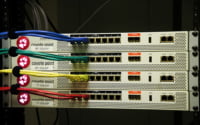Linux ‘SAR’ Command | Installation and Usage Guide

Are you looking to install the sar command on your Linux system but aren’t sure where to start? Many Linux users might find the task intimidating, yet, sar is a utility worth mastering. Installing sar will make it easy to keep an eye on your Linux system’s activity. SAR is readily available on most package management systems, making it a straightforward process once you know-how.
In this tutorial, we will guide you on how to install the sar command on your Linux system. We will show you methods for both APT and YUM-based distributions, delve into compiling sar from source, installing a specific version, and finally, how to use the sar command and ensure it’s installed correctly.
So, let’s dive in and begin installing sar on your Linux system!
TL;DR: How Do I Install and Use the ‘sar’ Command in Linux?
The
'sar'command is part of the sysstat package. You can verify this with,sar -V. However, if it isn’t installed to your system, you can add it withsudo yum install sysstatorsudo apt-get install sysstat. To install it on Debian-based distributions like Ubuntu, use the following command:
sudo apt-get install sysstat
For RPM-based distributions like CentOS, use this command:
sudo yum install sysstat
Once installed, you can use sar followed by various options to monitor different system activities. For example, to display CPU usage, you can use the following command:
sar -u
This will display the CPU usage statistics.
# Output:
# Linux 4.18.0-25-generic (anton-VirtualBox) 07/04/2021 _x86_64_ (1 CPU)
# 12:00:01 AM CPU %user %nice %system %iowait %steal %idle
# 12:10:01 AM all 0.33 0.00 0.13 0.00 0.00 99.54
This is just a basic way to install and use the sar command in Linux, but there’s much more to learn about sar and its powerful system monitoring capabilities. Continue reading for more detailed information and advanced usage scenarios.
Table of Contents
- Getting Started with SAR Command in Linux
- Installing SAR from Source Code
- Installing Different Versions of SAR
- Using SAR and Verifying the Installation
- Exploring Alternative System Monitoring Tools in Linux
- Troubleshooting Common SAR Command Issues
- Understanding System Monitoring in Linux
- Broadening Your System Monitoring Horizons
- Wrapping Up: Installing the ‘sar’ Command in Linux
Getting Started with SAR Command in Linux
The System Activity Report (SAR) is an essential tool for every Linux user, especially system administrators. It collects, reports, and saves system activity information, enabling you to monitor system performance and troubleshoot issues.
Why use SAR? It’s a versatile tool that provides a wealth of information, from CPU usage and memory paging to disk I/O, network statistics, and more. With SAR, you can track performance trends and identify bottlenecks, making it a must-have for maintaining a healthy Linux system.
Installing SAR with APT
For Debian-based distributions like Ubuntu, you can install the SAR command, which is part of the sysstat package, using the Advanced Packaging Tool (APT). Here’s how:
sudo apt-get update
sudo apt-get install sysstat
This will update your package lists and install sysstat. You can verify the installation with the following command:
sar -V
# Output:
# sysstat version 11.6.3
# (C) Sebastien Godard (sysstat <at> orange.fr)
Installing SAR with YUM
For RPM-based distributions like CentOS, you can use the Yellowdog Updater, Modified (YUM) to install sysstat. Here’s the command you need:
sudo yum install sysstat
Again, verify the installation with sar -V.
Monitoring System Activities with SAR
Once SAR is installed, you can start monitoring different system activities. For instance, to view CPU usage, use the -u option with the sar command:
sar -u
# Output:
# Linux 4.18.0-25-generic (anton-VirtualBox) 07/04/2021 _x86_64_ (1 CPU)
# 12:00:01 AM CPU %user %nice %system %iowait %steal %idle
# 12:10:01 AM all 0.33 0.00 0.13 0.00 0.00 99.54
This output provides a snapshot of CPU usage at the time the command was run, with statistics for user processes, system processes, idle processes, and more. With these insights, you can start making informed decisions about your system’s performance and resource allocation.
Installing SAR from Source Code
While package managers like APT and YUM make it easy to install SAR, you might want to compile it from source code. Installing from source allows you to customize the installation and get the latest features.
Here’s how you can do it:
- First, download the latest source code from the official sysstat GitHub repository.
Unpack the downloaded file with the following command:
tar -xvf sysstat-XX.XX.tar.gz
Replace XX.XX with the version number you downloaded.
- Navigate to the sysstat directory:
cd sysstat-XX.XX/
- Compile and install the source code:
./configure
make
sudo make install
- Verify the installation:
sar -V
Installing Different Versions of SAR
Different versions of SAR come with unique features and improvements. Depending on your needs, you might want to install a specific version.
Installing Specific Versions from Source Code
To install a specific version from source code, you just need to download the correct version from the sysstat releases page on GitHub. Then follow the same steps as above.
Installing Specific Versions with APT and YUM
To install a specific version with APT or YUM, you need to specify the version number in the install command. Here’s how:
APT
sudo apt-get install sysstat=XX.XX
YUM
sudo yum install sysstat-XX.XX
Remember to replace XX.XX with the version number.
Version Comparison
| Version | Key Features | Compatibility |
|---|---|---|
| 12.0.1 | Enhanced network statistics | Linux 2.6.31 or later |
| 11.4.2 | Added support for persistent device names | Linux 2.6.31 or later |
| 10.2.1 | Introduced disk and network statistics per partition | Linux 2.6.31 or later |
Using SAR and Verifying the Installation
Basic Usage of SAR
You can use SAR to monitor various system activities. For instance, to display memory usage statistics, you can use the -r option:
sar -r
# Output:
# Linux 4.18.0-25-generic (anton-VirtualBox) 07/04/2021 _x86_64_ (1 CPU)
# kbmemfree kbmemused %memused kbbuffers kbcached kbcommit %commit kbactive kbinact kbdirty
# 1618728 611968 27.44 53460 354084 89196 2.15 266628 289444 132
Verifying the Installation
You can verify the correct installation of SAR by checking its version number with the -V option:
sar -V
# Output:
# sysstat version 12.1.3
# (C) Sebastien Godard (sysstat <at> orange.fr)
This output confirms that SAR is installed correctly and displays its version number.
Exploring Alternative System Monitoring Tools in Linux
While the sar command is a powerful tool for system monitoring in Linux, it’s not the only one available. There are several other commands and tools that you can use to monitor your system’s performance. Let’s explore some of them.
The ‘top’ Command
The top command is a real-time system monitor that displays a dynamic view of the processes running on a system. It’s one of the most commonly used commands for system monitoring.
top
# Output:
# top - 15:23:33 up 2:00, 1 user, load average: 0.00, 0.01, 0.05
# Tasks: 88 total, 2 running, 86 sleeping, 0 stopped, 0 zombie
# %Cpu(s): 0.7 us, 0.3 sy, 0.0 ni, 98.9 id, 0.0 wa, 0.0 hi, 0.0 si, 0.0 st
# MiB Mem : 1990.8 total, 1113.9 free, 507.3 used, 369.6 buff/cache
# MiB Swap: 1024.0 total, 1024.0 free, 0.0 used. 1302.0 avail Mem
The top command provides a live scrolling view of the current state of the system, and it updates every few seconds. It’s an excellent tool for real-time monitoring and troubleshooting.
The ‘vmstat’ Command
The vmstat (virtual memory statistics) command provides information about processes, memory, paging, block IO, traps, and cpu activity.
vmstat
# Output:
# procs -----------memory---------- ---swap-- -----io---- -system-- ------cpu-----
# r b swpd free buff cache si so bi bo in cs us sy id wa st
# 1 0 0 1139952 55648 363868 0 0 39 35 115 220 1 0 99 0 0
The vmstat command is particularly useful for tracking down performance issues related to memory usage.
The ‘iostat’ Command
The iostat command reports CPU statistics and input/output statistics for devices and partitions. It’s a part of the sysstat package, just like sar.
iostat
# Output:
# Linux 4.18.0-25-generic (anton-VirtualBox) 07/04/2021 _x86_64 (1 CPU)
# avg-cpu: %user %nice %system %iowait %steal %idle
# 0.33 0.00 0.13 0.00 0.00 99.54
The iostat command is useful for monitoring disk I/O statistics, which can be crucial for performance tuning and troubleshooting.
Choosing the Best Tool
Each of these commands has its unique features and use cases. The top command is best for real-time monitoring, vmstat is excellent for memory-related issues, and iostat is ideal for disk I/O statistics. Meanwhile, sar provides a comprehensive view of system performance.
Choosing the best tool depends on your specific needs and the kind of information you’re looking for. You might even use a combination of these tools for a more holistic view of your system’s performance.
Troubleshooting Common SAR Command Issues
As with any tool, you might encounter some issues when using the sar command. Let’s go through some of the common problems and their solutions.
SAR Command Not Found
If you encounter a ‘command not found’ error when trying to use sar, it’s likely because the sysstat package is not installed. You can confirm this by attempting to display the version of sysstat using the following command:
sar -V
# Output:
# Command 'sar' not found, but can be installed with:
# sudo apt install sysstat
As the output suggests, you can install sysstat using the package manager for your distribution (APT, YUM, etc.).
No Data Available for Today
If you see a ‘No data available for today’ message when running sar, it means that the sadc service is not collecting system activity data. You can verify this with the following command:
systemctl status sysstat
# Output:
# ● sysstat.service - Resets System Activity Data Collector
# Loaded: loaded (/lib/systemd/system/sysstat.service; enabled; vendor preset: enabled)
# Active: inactive (dead)
If the service is inactive (dead), you can start it with this command:
sudo systemctl start sysstat
SAR: Can’t Open /var/log/sysstat/saXX
If you encounter a ‘Can’t open /var/log/sysstat/saXX’ error, it means that the SAR utility can’t find the system activity data file for the specified day (XX). This could be because the sysstat service is not running, or the data file has been moved or deleted.
You can check if the sysstat service is running with the systemctl status sysstat command. If the service is running, you might need to check the /var/log/sysstat/ directory for the data files.
Understanding SAR Output
The sar command provides a wealth of information, but it can be overwhelming if you’re not familiar with the terminology. To help you understand the output, here’s a brief explanation of some common terms:
%user: Percentage of CPU utilization that occurred while executing at the user level (application).%system: Percentage of CPU utilization that occurred while executing at the system level (kernel).%iowait: Percentage of time that the CPU or CPUs were idle during which the system had an outstanding disk I/O request.%idle: Percentage of time that the CPU or CPUs were idle and the system did not have an outstanding disk I/O request.
Remember, the sar command is a powerful tool for monitoring system performance, but it requires some understanding and practice to use effectively. Don’t be discouraged if it seems complex at first. With time and experience, you’ll be able to harness its full potential.
Understanding System Monitoring in Linux
To fully comprehend the power and utility of the sar command, it’s essential to have a solid grasp on the concept of system monitoring in Linux. System monitoring is a crucial part of maintaining a healthy and efficient Linux system. It involves observing and checking the status of system resources, processes, and network statistics over time.
Why is System Monitoring Important?
System monitoring is a critical aspect of system administration. It allows administrators to understand the state of the system, identify potential issues, and troubleshoot problems before they escalate. Regular system monitoring can lead to improved system performance, better resource allocation, and ultimately, a more stable and reliable system.
sar -q
# Output:
# Linux 4.18.0-25-generic (anton-VirtualBox) 07/04/2021 _x86_64_ (1 CPU)
# 12:00:01 AM runq-sz plist-sz ldavg-1 ldavg-5 ldavg-15 blocked
# 12:10:01 AM 1 113 0.00 0.01 0.05 0
In this example, we used the sar -q command to display queue length (runq-sz) and load averages. The load average represents the average system load over a period of time. A high load average indicates that the system resources are heavily used, and there might be a performance issue.
The Role of the ‘sar’ Command in System Monitoring
The sar command is a part of the sysstat package, a collection of utilities for system monitoring in Linux. It stands out due to its ability to collect and report a wide range of system activity information, from CPU usage and memory paging to disk I/O and network statistics.
With sar, you can monitor system performance in real-time or collect data at regular intervals for later analysis. This versatility makes sar a powerful tool for both immediate troubleshooting and long-term system performance optimization.
In summary, system monitoring is a crucial aspect of Linux system administration. Tools like the sar command make this task easier by providing detailed and accurate system activity data, helping you maintain a healthy and efficient system.
Broadening Your System Monitoring Horizons
System monitoring is not just a task; it’s an essential aspect of system administration and security. It goes beyond just installing and using the sar command in Linux. It’s about understanding your system, identifying potential issues, and taking proactive measures to ensure optimal performance and security.
System Monitoring and Administration
System monitoring plays a crucial role in system administration. It provides administrators with the data they need to make informed decisions about resource allocation, system performance optimization, and troubleshooting. With tools like sar, administrators can keep a close eye on various system metrics and take immediate action when something goes wrong.
System Monitoring and Security
System monitoring is also a critical aspect of system security. By monitoring system activity, administrators can detect unusual patterns or anomalies that might indicate a security threat. For instance, a sudden spike in CPU usage might suggest a malware infection, while an unexpected increase in network traffic could be a sign of a DDoS attack.
Exploring Related Concepts
If you’re interested in system monitoring, you might also want to explore related concepts like process management and system performance optimization. Process management involves controlling and managing system processes, while system performance optimization is about improving system efficiency and performance.
Commands like ps, top, and htop can help you manage processes, while tools like nice, renice, and ionice can help you optimize system performance.
Further Resources for System Monitoring Mastery
If you want to delve deeper into system monitoring in Linux, here are some resources that you might find useful:
- Linux Performance: This site by Brendan Gregg, a senior performance architect at Netflix, offers a wealth of information on Linux performance, including tools, methodologies, and a performance analysis checklist.
Linux System Monitoring, Server Health Monitoring, and Network Monitoring Tools: Tecmint’s comprehensive guide to Linux system monitoring tools can help you broaden your monitoring toolkit beyond just
sar.The Geek Stuff: This blog offers a variety of tutorials and guides on Linux commands and shell scripting, including system monitoring tools and techniques.
Wrapping Up: Installing the ‘sar’ Command in Linux
In this comprehensive guide, we’ve journeyed through the process of installing and using the sar command in Linux, an essential tool for system monitoring. Whether you’re a beginner just starting out or an intermediate user looking to level up, this guide has provided you with the knowledge and skills to effectively monitor your system’s performance using sar.
We began with the basics, learning how to install the sar command using package managers like APT and YUM. We then ventured into more advanced territory, exploring how to compile sar from source code, install specific versions, and use sar to monitor various system metrics. We also delved into troubleshooting, providing solutions to common issues that you might encounter when using sar.
Along the way, we compared sar with other system monitoring tools in Linux, such as top, vmstat, and iostat, giving you a broader perspective on the landscape of system monitoring tools. Here’s a quick comparison of these tools:
| Tool | Pros | Cons |
|---|---|---|
sar | Comprehensive, supports many metrics | Requires some understanding of system metrics |
top | Real-time monitoring, easy to use | Limited metrics, less detailed than sar |
vmstat | Provides memory statistics | Less comprehensive than sar |
iostat | Provides disk I/O statistics | Less comprehensive than sar |
Whether you’re just starting out with system monitoring in Linux or you’re looking to level up your skills, we hope this guide has given you a deeper understanding of the sar command and its capabilities. With its comprehensive features and versatility, sar is a powerful tool for system monitoring in Linux. Happy monitoring!


